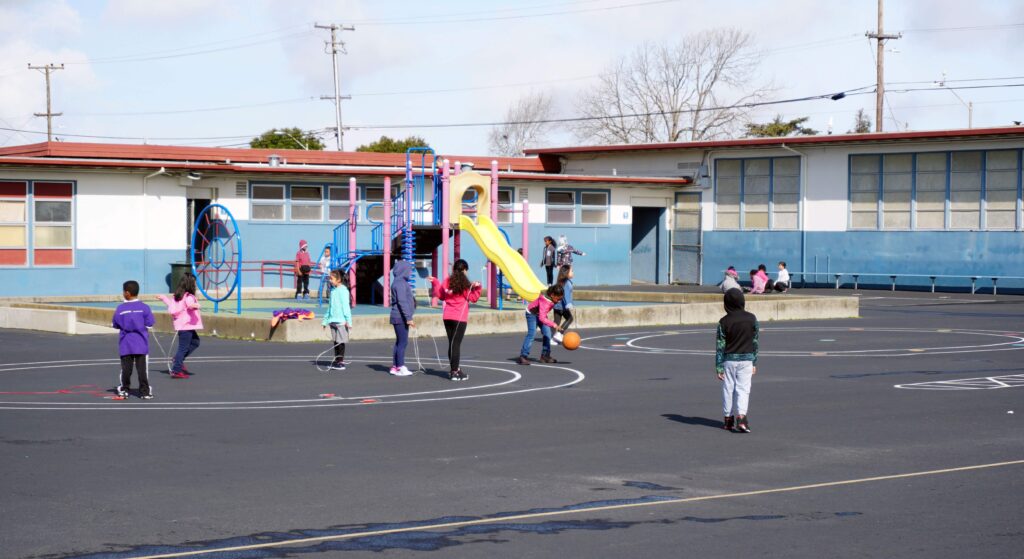
Californians remain anxious about the mental health of public school students four years after the Covid virus closed down schools, according to a new survey released Wednesday. They also indicated they’re lukewarm toward passing a statewide school construction bond.
In the Public Policy Institute of California’s survey of 1,605 California adult residents, 81% of all adults and public school parents said they were strongly or somewhat concerned about students’ mental health and well-being – a view that, for most part, cut across race, political party affiliation and family income. The number reflects a continuing worry about the persistent impact of the pandemic two years after students returned to the classroom following school closures of more than a year.

Advocates for a statewide bond to build and repair TK-12 school facilities may face an uphill battle to pass it – assuming Gov. Gavin Newsom and legislators put the issue before voters in November.
Only 53% of likely voters said they would vote for a state bond, while 44% said they’d vote no, with only 3% undecided, according to the Public Policy Institute of California, which on Wednesday released its annual survey of voters’ view on TK-12 education issues. The number is well below 60%, the standard level of favorability that comforts backers of an initiative heading into a campaign.
The mid-March survey also found mixed views on how Newsom and the Legislature are handling the state education system; 51% of all Californians and 60% of public school parents said they liked how he had managed education. That’s the lowest number since his election in 2018, and consistent with PPIC’s most recent survey on his overall job performance. The survey had a margin of error of 3.3% plus or minus.
Newsom’s highest rating was in April 2020, when 73% of likely voters approved and 26% disapproved of his performance on TK-12 education. That coincided with the emergence of the coronavirus, and his decision to close schools. “Newsom got a bump in the early days of the crisis for responding decisively amid the shock of the pandemic,” said Mark Baldassare, survey director and chair of public policy for PPIC.
The Legislature and State Superintendent of Public Instruction Tony Thurmond also received roughly 50% approval in the latest survey; however, the poll also showed that most Californians agreed with their positions on social and political issues that captured headlines in the past year.
- 69% of all adults said they strongly (43%) or somewhat (26%) oppose individual school boards passing laws to ban and remove certain books from classrooms and school libraries; a smaller majority of public school parents (30% strongly, 25% somewhat) agreed. Last year, Newsom threatened to fine Temecula Valley Unified and replace a social studies textbook that the board rejected because it included a reference to the late gay activist Harvey Milk; the board reversed its position.
- 58% of all adults and 55% of public school parents oppose individual school boards creating policies to restrict what subjects teachers and students can discuss in the classroom.
- More than 80% of adults and public school parents strongly or somewhat favor teaching about the history of slavery, racism, and segregation in public schools; more than 50% of all respondents strongly held that view.
- Local schools got good marks for preparing students for college, but less so the workforce. 60% of all adults and 72% of public school parents said their schools did well preparing students for college, while 51% of all adults and 65% said they did a good job preparing students for jobs and the workforce. Only 45% of African American respondents said the schools did a good job for college, compared with 64% of Asian Americans, 61% of Latinos and 61% of Whites.
As with these and many of the issues surveyed, there was a sharp partisan division, with most Democrats supporting Newsom’s positions and most Republicans opposing them.
California adults were about evenly split (50% support, 49% oppose), however, on whether to allow books with stories about transgender youth in public schools. Three in four Democrats support this, while eight in 10 Republicans oppose it, and independents are divided (51% support, 48% oppose). Only 42% of public school parents support the idea, and 57% said they oppose it; they also opposed including lessons on transgender issues by the same breakdown.
Newsom and the Legislature have committed billions of dollars to phase in voluntary transitional kindergarten for all 4-year-olds. Two-thirds of all adults, including 77% of public school parents, 80% of Democrats, 41% of Republicans, 84% of Blacks, and 57% of Whites, said that’s a good idea.
Uncertainty about bond issue
Newsom said in January that he supports placing a school construction bond on the November statewide ballot; voters last passed a state bond in 2016, and the state has run out of money to contribute to districts’ share of new construction and renovations.
However, Newsom and legislative leaders have not negotiated the specifics. School consultant Kevin Gordon, president of Capitol Advisors, said that polling results could affect the size and scope of a bond. Instead of a $15 billion bond that legislative leaders have discussed, it could be much less; instead of including money for the University of California and California State University, which polls less favorably than TK-12, it could include money only for TK-12 and community colleges, he said.
Gordon and Baldassare disagreed on how much to read into the 53% support of the bond eight months before the election.
“All of the not-so-good news about the state budget, with billions of dollars in red ink, has had an impact on voters’ attitude that affects the bond issue now,” Gordon said. “But after this summer, with a balanced budget adopted, and with economists optimistic about the latter part of 2024, voters’ attitude could change.”
 Credit: Public Policy Institute of California, April 2024 survey
Credit: Public Policy Institute of California, April 2024 surveyFour years ago, voters rejected a state bond 46% to 54% in the March 2020 primary election. But, Gordon said, voters have never defeated a state bond initiative in a November election, which attracts more people to the polls.
Baldassare said the bare majority support in the survey shows “there is a lot of economic anxiety among voters over inflation and anxiety over taking on more debt.” That showed in the bare passage last month, with 50.2% of the vote, of Proposition 1. It will determine how to spend money on housing for unhoused people suffering from mental illness.
The survey also produced mixed, and perhaps puzzling results to the same questions asked in previous surveys:
Asked “how concerned are you that California’s K-12 public school students in lower-income areas are less likely than other students to be ready for college,” 39% this year said “very concerned.” That’s the lowest percentage since the question was introduced in 2010, when 59% said they were very concerned.
Asked, “How would you rate the quality of public schools in your neighborhood today,” 49% of likely voters gave their schools an A or B. That’s nine percentage points higher than last year and in pre-pandemic 2019.
Asked whether the quality of education has gotten worse over the past few years, 52% of adults said it was worse, 11% said it had improved, and 34% said about the same. That was an improvement from last year, when 62% said education had gotten worse and only 5% said it had improved – and far better than in 2011. That was during the depths of the Great Recession, when school districts were slashing budgets following cuts in state revenue: that year, 62% said schools had gotten worse.






